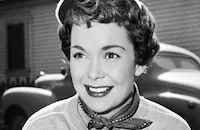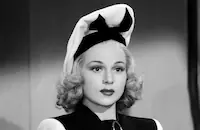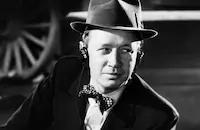Flight Angels

Brief Synopsis
Cast & Crew
Lewis Seiler
Virginia Bruce
Dennis Morgan
Wayne Morris
Ralph Bellamy
Jane Wyman
Film Details
Technical Specs

Synopsis
Chick Farber, a crack pilot for a commercial airline, has a girl in every airport, although his real love is stewardess Mary Norvell. In addition to piloting, Chick and his co-pilot, Artie Dixon, are building a revolutionary new aircraft named the strato-liner. Artie's devotion to his new plane angers his sweetheart, stewardess Nan Hudson, who has been trying to convince the co-pilot to marry her. While taking a routine physical examination, Chick fails the eye test and is grounded by company manager Bill Graves. Bill, with the help of Mary, convinces the dejected Chick to take a job as an instructor at the stewardess training school, and when Chick impulsively proposes to Mary, the couple elope before he starts his new position.
Chick finds that he has little patience for his giggling new students, however, and soon quits his job. Chick suffers another blow when he learns that Lt. Parsons has been assigned to test the strato-liner, and he angrily steals the plane to conduct his own test flight. All goes well until Chick's eyesight fails him and he crashlands the plane. With his license suspended, Chick tells Mary that he is leaving her to enlist in the Chinese Air Service. En route to China, Chick stops in San Francisco, where he drafted by the army to teach in their flight instruction school. Soon afterward, Bill abruptly changes Mary's assignment to a flight bound for San Antonio, and she is puzzled until Chick meets her at the airport where he is working as a flight instructor and asks her to stay on as his wife.

Director
Lewis Seiler
Cast

Virginia Bruce

Dennis Morgan

Wayne Morris

Ralph Bellamy

Jane Wyman

John Litel

Margot Stevenson
Dorothea Kent

John Ridgely
Lucile Fairbanks

Maris Wrixon
Phyllis Hamilton

Carol Hughes

Mary Anderson
Dewolfe Hopper
Jan Clayton

Marilyn Merrick
Leona Roberts
Ferris Taylor
Dick Elliott

John Arledge
Janet Shaw

Natalie Moorhead

Grace Stafford

Nell O'day
Elizabeth Sifton
Jean O'donnell
Victor Zimmerman
Peter Ashley
Charles Sullivan
Peggy Keyes
Ann Roberts
Kay Nacke
Sol Gorss
Robert Prins
Michael Harvey
Sonny Bupp
Margaret Marquis

Rosella Towne
Terry Nibert

Eddie Acuff
Charles Sherlock
Garland Smith
Dutch Hendrian
Owen King
Jack Gardner
Jeffrey Sayre
Carlyle Moore Jr.
Creighton Hale

Addison Richards
Tony Hughes
Crew
Milo Anderson
Edwin Dupar
Robert Foulk
Bryan Foy
James Gibbon
Edmund Grainger
Byron Haskin
Maurice Leo
Arthur Lueker
Richard Macaulay
L. William O'connell
Hugh Reticker
A. T. Schmidt
Dolph Thomas
Jerry Wald
Jack L. Warner
Perc Westmore

Photo Collections
Film Details
Technical Specs

Articles
Flight Angels
The world's first "flight angel" was a woman named Ellen Church, who on May 15, 1930, began work for Boeing Air Transport on its Oakland, California to Chicago, Illinois route. In those days, the requirements were that they be single, no older than 25, weigh less than 115 lbs, with a height no greater than 5 feet four inches, and be a registered nurse.
For Hollywood, which had confined its air dramas mainly to World War I pictures or the daring exploits of barnstormers or air mail pilots, the invention of the flight attendant took women from their usual role of the girlfriend/wife who waited and worried on the ground and into the plane along with the men, making her part of the action. Flight Angels (originally titled Women Are Tough Angels), a film which would be considered a "B" picture or a second feature, uses this 'pilot/flight attendant' romance, though by 1940 the plot was wearing thin. As the New York Times May 27, 1940 review was quick to point out, Flight Angels required "close scrutiny to distinguish it from numerous other manufactured melodramas of men, women and planes. Is there intramural warfare amid the cloud-bound lassies over the pilot of Flight Number 8? There is. Is there a hard-boiled field superintendent in love with the favored lady? Call him Ralph Bellamy. Does an irritating young hero, after being grounded for failing eyesight, make an unauthorized test flight in the company's new plane, crack up and head for China to fight the Japanese? Not quite. He finds himself in the arms of Virginia Bruce instead. Cliché will have its way. As a program piece for folk whose affinity for high altitudes continues to be nothing short of mystic, the story has been interlarded with some baldly stated facts and statistics on the careers of the crisp young women who fetch bicarbonate of soda for airsick passengers. But the informative asides, like the plot and the sequence of a plane plummeting earthward, are too familiar to be the film's raison d'être. The actors, however, try to speak their lines as though they were brand-new. Miss [Virginia] Bruce, especially, as the stewardess who becomes an impromptu midwife at 8,000 feet, conveys the impression that she'd be a mighty reassuring person to have around during a crisis like that."
The cast of Flight Angels contained Virginia Bruce who had been in films since 1929, and once had leading roles in "A" pictures at MGM, but her career was on the decline. Ralph Bellamy, who practically made a career playing the man the leading lady didn't marry, had played this role so often he would stay away from Hollywood for five years beginning in 1945 to return to the stage where he found better roles. Jane Wyman, playing Bruce's rival, was working her way up, beginning as an extra and transitioning to supporting roles. Five months before Flight Angels was released she had married another Warner Bros. contract player named Ronald Reagan. The studio milked all the publicity they could out of the marriage, but once the hype died down, continued to put both Reagan and Wyman in lesser films. Her career would pick up in a few short years, when she won the Best Actress Oscar® for Johnny Belinda (1948).
Flight Angels would be little more than a blip on the radar screen in the careers of most of the cast members. The exception was Wayne Morris. For Morris, who played pilot Artie Dixon, the film would have a profound effect on his life. During shooting, he became fascinated with flying and shortly after became a pilot. The Internet Movie Database reports that "[w]ith war in the wind, he joined the Naval Reserve and became a Navy flier in 1942, leaving his film career behind for the duration of the war. Assigned to the carrier Essex in the Pacific, Morris shot down seven Japanese planes and contributed to the sinking of five ships. He was awarded four Distinguished Flying Crosses and two Air Medals." Wayne Morris died of a heart attack in 1959, at age 45, while watching aerial maneuvers from the air craft carrier Bon Homme Richard in San Francisco Bay. He was buried at Arlington Cemetery with full military honors.
Producer: Edmund Grainger, Bryan Foy
Director: Lewis Seiler
Screenplay: Jerry Wald, Richard Macaulay, Maurice Leo
Cinematography: L. William O'Connell
Film Editing: James Gibbon
Art Direction: Hugh Reticker
Cast: Virginia Bruce (Mary Norvell), Dennis Morgan (Chick Farber), Wayne Morris (Artie Dixon), Ralph Bellamy (Bill Graves), Jane Wyman (Nan Hudson), John Litel (Dr. Barclay).
BW-74m. Closed captioning.
by Lorraine LoBianco
Sources:
Wikipedia.org
PBS.org
The Internet Movie Database Jane Wyman: A Biography by Joe Morella and Edward Z. Epstein

Flight Angels
Quotes
Trivia
Notes
The working title of this picture was Flight Eight. According to a news item in Hollywood Reporter, Warner Bros. suspended Olivia de Havilland for refusing the female lead in this picture. A Hollywood Reporter production chart credits Tom Reed with screenplay, but his contribution to the final picture has not been confirmed. According to the Variety review, this was Edmund Grainger's first production for Warner Bros. Flight Angels marked the motion picture debut of actress Lynn Merrick (1921-2007), who was billed as Marilyn Merrick on this and two other 1940 films until changing her first name to Lynn in 1941.















